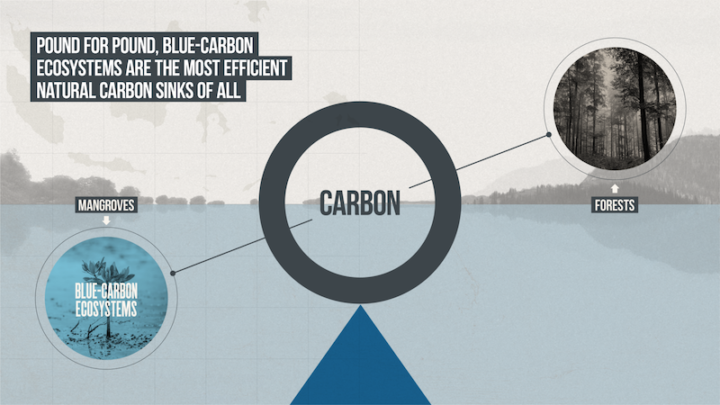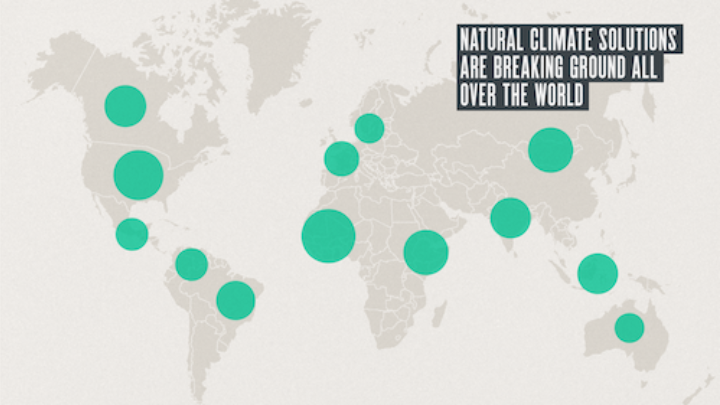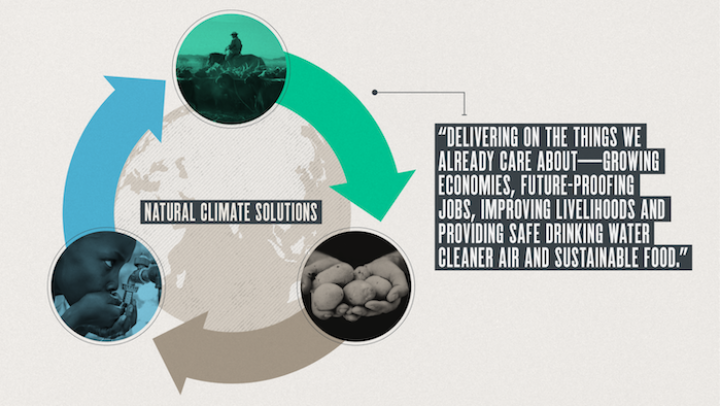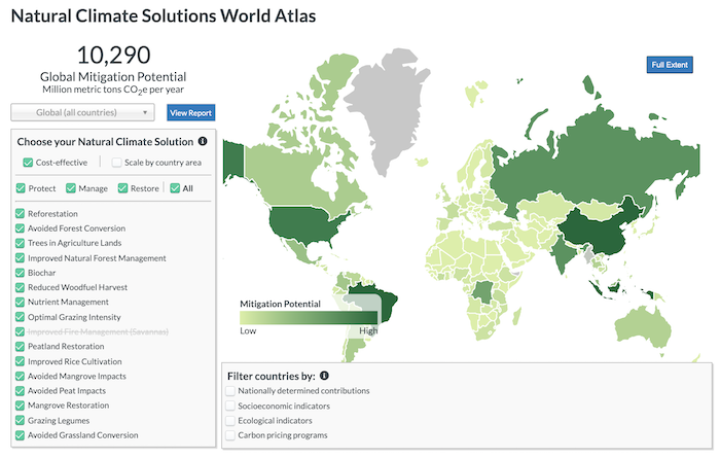Growing Up: The story of natural climate solutions
A brief history of how science and movement building came together to take natural climate solutions (NCS) from concept to implementation.

By John Lang
Share
Last updated:
The story of natural climate solutions (NCS) has barely begun, but it’s already worth telling.
In this century’s supertanker-U-turn challenge, unleashing nature is now as permanent a fixture at the climate wheelhouse as any. But that’s not always been the case: in 2015, only three academic papers were dedicated to NCS; in 2019, that figure had grown to 100+. Hundreds more are in store as policymakers focus their attention on COVID-19 recoveries. After all, investing in nature delivers on climate, economic and social necessities.
In many ways, what the IPCC Special Report on 1.5°C did for net zero by 2050, a groundbreaking 2017 paper did for nature-based solutions to climate change. Published in the Proceedings of the National Academy of Sciences, Natural Climate Solutions was as fetching as it was foundational: ‘NCS can provide over one-third of the cost-effective climate mitigation needed between now and 2030 to stabilise warming to below 2°C’. Led by Dr. Bronson Griscom, scientists from 19 organisations found much of that natural mitigation — be it protecting mangroves, restoring forests or better managing farms — could be delivered at or below $10 per tonne of CO2.
The potential was palpable. But as NCS scientist Susan Cook-Patton admits, to realise that potential ‘there was immediate recognition that NCS science had to get more regional, more sophisticated’. Griscom had captured the size of the prize, but translating that into utility was another story altogether.
Foundational to functional
In 2018, the US opportunity was brought to life. Working with national-level data sets, Fargione et al quantified the potential of 21 NCS to increase carbon storage and avoid emissions — largely through reforestation and improved land-management. Finding a maximum yearly potential of the equivalent of 21% of current net annual emissions, they confirmed that despite being at the apex of industrialised nations, a significant part of low-cost US climate action should be NCS.
Griscom’s team has more recently zoomed in on the equator: tropical countries make up over 60% of the NCS pie, often lack their own research capacity and tend to have large agrarian sectors as a proportion of domestic emissions. In January, they found that half of the 76 tropical countries could mitigate over 50% of their national GHG emissions cost effectively with NCS; in more than a quarter, cost-effective NCS potential is greater than national emissions. In Griscom’s own words, ‘many countries can go way beyond carbon neutral with NCS alone!’ Another recent equatorial-focused paper found that just ten tropical countries comprise 55% of potential low-cost abatement from tropical reforestation through to 2050 — by far the greatest NCS carbon-slashing opportunity, that is, after protecting existing forests.

In fact, avoiding deforestation in the first place can be as much as 10 times more cost-effective. An important 2018 paper shed light on the exceptional value of intact forest ecosystems and revealed that — take a deep breath — of Earth’s remaining forests, ‘as much as 82% is now degraded to some extent as a result of direct human actions’. A call for the restoration of dwindling intact forests to be an ‘urgent global priority’ didn’t seem commensurate to what is one of this century’s greatest challenges.

As for intact blue-forest ecosystems, mangroves reign supreme. A 2018 meta analysis confirmed that, pound for pound, mangrove ecosystems are the most efficient natural carbon sinks of all — a potential stymied only for lack of planetary extent. Still — mangroves mitigate more than 1% of national fossil fuel emissions for countries including Bangladesh, Colombia and Nigeria.
Wall-to-wall
A Cook-Patton-led paper just released in Nature has zoomed in even further, mapping potential carbon accumulation rates from natural forest regrowth using over 13,000 georeferenced data points. While not intended to replace robust national or site-specific data, the 1-km resolution map scientifically illuminates estimates of the potential carbon returns from letting forest grow back in any part of the planet. Due to the improved mapping and understanding of areas of opportunity, the paper revises the maximum mitigation potential in Griscom’s 2017 paper downwards by about 11%. But what is lost to potential is gained in accuracy — the world’s first ‘wall-to-wall global map’ for assessing natural forest regrowth as a mitigation strategy represents the kind of progress scientists like best: that which can be applied directly and immediately to policy.
Interrogating NCS’s own limits
NCS has also been introspecting. Nathalie Seddon, Xiaojuan Liu, Chantal Hutchison and others set their scowl on monoculture plantations, which rapidly sequester carbon but do not always guarantee or maximise long-term carbon storage. Monocultures are vulnerable to disease, pests and climate extremes — so, instead it’s about the ‘right trees in the right place’. Time and time again, it’s been shown there is greater stability of carbon capture in species-rich natural forests compared with species-poor plantations. To help clarify nature-based solutions writ large, the International Union for Conservation of Nature (IUCN) recently published its ‘Global Standard’ criteria for what constitutes an effective nature-based solution that works with nature, not against it. In other words, solutions that mop up carbon, boost biodiversity and are resilient in a warming planet.

A useful blueprint for reforestation globally in Science prompted broader introspection. The study was lauded for locating half the world’s forest restoration potential (in Australia, Brazil, Canada, China, Russia and the US), but it wasn’t getting away with touting trees as ‘our most effective climate change solution to date’. A collective riposte could be heard from science and policy experts around the world: reforestation is but one solution of many that governments must prioritise, including the most important of all: turning off the fossil fuel CO2 tap as quickly as possible.
Right here, right now
As NCS science zooms in, it gathers more accuracy, more pixelation, more preciseness. But for NCS policy to stay abreast with the science, it’s got to get more real. Cook-Patton is excited by the now ubiquitous ‘pixels of opportunity’ but she’s impatient to get going — to ‘fail fast and fail forward’ as she perspicuously puts it.
But there is a problem. As it stands, NCS only receives around 3% of the funding for all human carbon-cutting efforts. Or think about it another way: we spend 1,000 times more on subsidising fossil fuels globally than we do on NCS. Finance is still the weakest link, but according to Griscom, the ballooning awareness of the climate emergency and NCS is helping. Awareness efforts by prominent activists are beginning to channel minds, while funding commitments by big corporates, for example HSBC, Amazon and Total, are beginning to channel finance.
According to Cecile Girardin from the Nature-based Solutions initiative, another crucial focus must be ‘in strengthening NCS alignment’ between the UN Convention on Biological Diversity (CBD) and UN Framework Convention on Climate Change (UNFCCC). Delivering on the inextricably linked necessities of improving biodiversity and managing climate change depend on it. Next year at COP15 of the UN Convention on Biological Diversity in China, countries have an opportunity to refresh their shared commitments to biodiversity and nature. And ‘by 2020’ — so well before next year’s postponed UN climate summit in Glasgow — countries have perhaps their last opportunity to enhance their carbon-cutting pledges (NDCs) to deliver the 1.5°C goal of the Paris Agreement.

When Glasgow finally arrives, having every Paris Agreement party mention nature-based solutions in their updated pledges would be a significant improvement on only two-thirds in 2015. But as NCS science now shows and climate science unequivocally demands, all nations — whether tropical or industrialised, rich or poor — can be radically better off if they elevate NCS to spearhead those pledges.
The big and the scalable
Multilateral examples of NCS are mounting:
- The Bonn Challenge is scaling the forest landscape restoration approach across 62 governments, associations and companies to restore over 172 million hectares
- The Great Green Wall of Africa (GGWA) initiative is driving continent-wide natural regeneration and reforestation in Africa. Comprising 21 African nations, GGWA has planted 11.4 million trees in Senegal and restored 15 million hectares in Ethiopia (a country, incidentally, which planted 353 million trees in a single day last year)
- The 4 per 1000 initiative is unearthing ‘the forgotten solution’ beneath us so we stop treating soil like dirt
- Convened in the wake of the peatland fires in Indonesia, the Global Peatlands Initiative is working to protect and resurrect Earth’s largest terrestrial store of carbon
- The Global Mangrove Alliance is bullish about achieving its goal to increase the global area of mangrove habitat by 20% by 2030. Projects in the Philippines, Indonesia, Cameroon, Madagascar, Tanzania and Bangladesh are taking root
- Tree planting initiatives have exploded, each vying for numerical and empirical supremacy: first a million, then a billion, then a trillion — then a trillion again.

But as dawn breaks on the 2020s, NCS experts get most excited when scientifically- and socially-proven regional projects are scaled up. The Indian state of Andhra Pradesh, for example, has begun transitioning six million farmers to regenerative agricultural practices, rejuvenating its soil and economy. The Indian states of Himachal Pradesh and Karnataka already want to follow suit. In Kenya, the Green Belt Movement has planted 51 million climate-resilient trees to date, empowering communities and women along the way. Its success warrants replication, and not just on the African continent. Peatland protection initiatives, such as the Brazzaville Declaration in the Congo and Indonesia, are helping policymakers value the world’s largest store of natural terrestrial carbon. In Scotland, because a 2020 goal of restoring 50,000 hectares of peatland will likely be exceeded, it will extend the total to 250,000 hectares by 2030. Meanwhile in the Arctic, the Pleistocene Park project reminds us of those ecosystems where planting trees is not such a great idea. The ticket to a cooler climate in some areas of the permafrost is the restoration of pasture, not the sowing of pine seeds.
Back at ground level
Cook-Patton would like an answer to ‘how do we get people excited about ecosystem protection?’ Sandeep Segupta, of the IUCN, wants the ‘forgotten solution’ to not simply morph into the ‘forest solution’ — non-forest ecosystems, which can easily be lost among the trees, must be prioritised. Griscom would like to out-muscle ‘nature’s branding problem’ by better amplifying its secret sauce: ‘delivering on the things we already care about such as transforming and growing economies, future-proofing jobs, improving livelihoods and providing safe drinking water, cleaner air and sustainable food’. Nature’s secret, after all, sells itself — especially in the Time of Covid.

Helping you zoom in
Nature4Climate's NCS World Atlas has had a makeover. It still helps policymakers and the perplexed come to terms with NCS mitigation potential globally, but the influx of regionally-explicit science has injected it with more dynamism. A simple, intuitive interface brings it to life.

Jump in for yourself. Stay global or zoom in on your own country and choose between all pathways or simply those that peak your interest. From here, either:
- Toggle between NCS’s three pillars: Protect, Manage or Restore
- Play around with the full list of individual NCS from the get go. For example, deselect everything but Reforestation, Trees in Agriculture Lands and Peatland Restoration
- Or do both: select a pillar, say Protect, and deselect Avoided Forest Conversion to show the mitigation potential of mangroves and peatlands.
Better yet, select a Global indicator (or two) as a country filter to surface combinations of mitigation potential and/or locate where the most telling opportunities lie to advance NCS in policy, finance and implementation. For example, you could identify:
- countries that include nature in their Nationally determined contributions
- potential investment opportunities for NCS activities in Low income groups and countries with Carbon pricing programs
- those global regions where NCS interventions could enhance biodiversity (Tip: select Ecological indicators first)
In truth, filtering countries by global indicators is the raison d’etre of the Atlas, for it helps to inspire lateral thinking, generate questions, tell stories and identify opportunities.
NCS interactives are also improving elsewhere. For example, Nathalie Seddon and her team at the Nature Based Solutions initiative have captured a treasure trove of NCS information from science, policy and practice, and woven it into an online tapestry. Biodiversity and resilience focussed, the platform reminds policymakers what effective NCS has to look like in the 2020s.
Naturvation is another outstanding resource, illuminating NCS in urban landscapes. Its own Atlas now houses over 1000 examples.
Through the forest
NCS is always at risk of being caught in the trees. In fact, Cook-Patton loses sleep because of it: ‘What keeps me up at night is people think planting trees is enough’.
As tree planting steals journalists’ attention, NCS experts urge the world to shine the NCS torch more widely. Because with more light, improved funding and enhanced zoom, NCS can develop into a diversified story about protecting non-forest ecosystems, scaling up what works and planting the right things in the right places.
Nature and NCS may not have a voice of its own, but its story marches on.
This article was first published on Nature4Climate. You can use the new and improved NCS World Atlas for yourself here.
Share